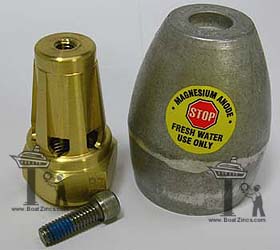Half Off
Member
Trying to decide which would be correct choice for Alpha 1 outdrives in fresh water. Is Aluminum good enough or should I go with Magnesium?
Follow along with the video below to see how to install our site as a web app on your home screen.

Note: This feature currently requires accessing the site using the built-in Safari browser.
Trying to decide which would be correct choice for Alpha 1 outdrives in fresh water. Is Aluminum good enough or should I go with Magnesium?
Absolutely magnesium.
We made the change last year and I could not believe how much it cut down on the corrosion of our Bravo III's.

Did you add the new prop anode for the pre-2004 BIII drives?
I have them on order. I will install before we splash.
So I guess the my next question would be - how would one tell if they have shore power with or without "galvanic isolation"?
So I guess the my next question would be - how would one tell if they have shore power with or without "galvanic isolation"?
(Aside, If anyone knows how to actually test their isolator to make sure it is functioning, please let me know.)